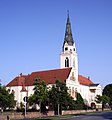The Greek Catholic Church in Croatia and Serbia[a] or Byzantine Catholic Church of Croatia and Serbia, is a particular (sui iuris) Eastern Catholic church in full communion with the Catholic Church. It consists of the Greek Catholic Eparchy of Križevci,[1] covering Croatia, Slovenia, Bosnia and Herzegovina, and the Greek Catholic Eparchy of Ruski Krstur,[2] covering Serbia. The Eparchy of Križevci is headed by Bishop Milan Stipić since 2020.[3] The Eparchy of Ruski Krstur is headed by Bishop Đura Džudžar since 2003 (until 2018 as Apostolic Exarch).[4]
| Greek Catholic Church in Croatia and Serbia | |
|---|---|
| Croatian: Grkokatolička crkva u Hrvatskoj i Srbiji Serbian: Гркокатоличка црква у Хрватској и Србији | |
 Coat of arms of Eparch Milan Stipić of the Eparchy of Križevci | |
| Classification | Eastern Catholic |
| Polity | Episcopal |
| Structure | two eparchies |
| Pope | Francis |
| Bishops | Milan Stipić, Đura Džudžar |
| Region | Bosnia and Herzegovina, Croatia, Serbia, Slovenia |
| Language | Church Slavonic |
| Liturgy | Byzantine Rite |
Although two eparchies are canonically linked, the church has no unified structure, nor an ecclesiastical province of its own, since the Eparchy of Križevci is suffragan to the Latin Church Archdiocese of Zagreb, and the Eparchy of Ruski Krstur is directly subject to the Holy See.
History
The Greek Catholic Church in Croatia has existed since the 16th century and was created by Christians of the Greek-Slavic rite who fled before the Turks from Bosnia and Slavonia and moved to the area of the Military Frontier (Vojna krajina) and the western parts of Croatia. The seat of the Greek Catholic Church in Croatia has been in Križevci since 1777.[5]
In May 1836, the first Ruthenian Greek Catholic parish in the territory of today's Croatia was founded in Petrovci. [6]
Until 2001, the Greek Catholic Eparchy of Križevci had full jurisdiction over all Eastern Catholics of the Byzantine Rite throughout the entire territory of former Yugoslavia, including all of its successor states: Croatia, Slovenia, Bosnia and Herzegovina, Serbia, Montenegro and North Macedonia. During that time, it mostly gathered its faithful among the Croats in central and eastern Croatia, among the Pannonian Rusyns and Ukrainians in eastern Croatia, northern Bosnia and northern Serbia and among Macedonians in North Macedonia.
After the formation of independent successor states from what had been Yugoslavia, the process of administrative reorganization was initiated. In 2001, a separate Greek Catholic Apostolic Exarchate of Macedonia was formed for Greek Catholics in North Macedonia. It was fully separated from the Eparchy of Križevci and proclaimed as directly subject only to the Holy See.[7]
In 2003, a new apostolic exarchate was created for Greek Catholics in Serbia and Montenegro, the Apostolic Exarchate of Serbia and Montenegro.[8] Its first exarch Đura Džudžar (Ђура Џуџар) was appointed in 2003, with residence in Ruski Krstur. This exarchate remained in association with the Eparchy of Križevci.
After those changes, the jurisdiction of the Eparchy of Križevci was confined to Croatia, Slovenia, and Bosnia-Herzegovina.
In 2013, all Catholics of Byzantine Rite in Montenegro were entrusted to the local Latin bishops, so the jurisdiction of Apostolic Exarchate of Serbia and Montenegro was reduced to Serbia only.[9] The Apostolic Exarchate of Serbia was elevated to the Greek Catholic Eparchy of Ruski Krstur in December 2018.[10]
Liturgy and extent
The liturgy is the Slavonic form of Byzantine Rite, using the Old Church Slavonic language and the Cyrillic alphabet.
The Eparchy of Križevci reported for the year 2010 a total of 21,509 faithful (in Croatia, Slovenia, and Bosnia-Herzegovina). At that time, the Apostolic Exarchate for Serbia and Montenegro reported 22,369 faithful.[11]
Gallery
- Cathedral of St. Nicholas in Ruski Krstur, Serbia
See also
Notes
- Latin: Ecclesia Graeco-Catholica Croatiae et Serbiae; Serbo-Croatian: Grkokatolička crkva u Hrvatskoj i Srbiji, Гркокатоличка црква у Хрватској и Србији
References
External links
Wikiwand in your browser!
Seamless Wikipedia browsing. On steroids.
Every time you click a link to Wikipedia, Wiktionary or Wikiquote in your browser's search results, it will show the modern Wikiwand interface.
Wikiwand extension is a five stars, simple, with minimum permission required to keep your browsing private, safe and transparent.



